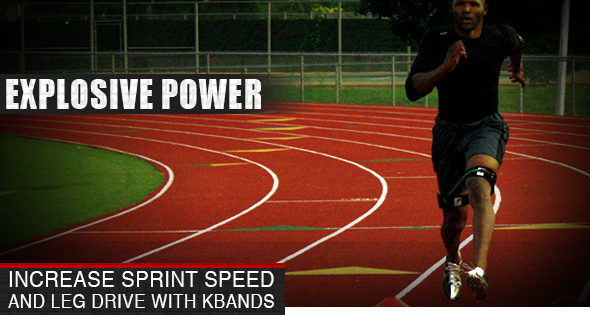Track and Field Ankling Sprints
Track and field athletes can benefit from any set of track training workouts that target both major and minor muscle groups that support speed. And the more varied a weekly set of workouts, the better, since almost every set of track workouts will target some muscle groups more than others. On some days, athletes can tackle sprinting workouts and full speed, natural running drills. And on other days, it’s a good idea to isolate the vary the stride or pace of the workout and isolate certain muscle groups in order to strengthen those that need more attention.
The set of sprinting workouts demonstrated in this drill are called track and field ankling sprints, and these exercises can help runners gain the maximum advantage from the resistance of the Kbands. When the bands are in place, the isolation created by this unique stride can apply high levels of tension to the hip flexors, glutes, and core. After a round of these sprinting workouts, runners will be able to feel the difference and experience a lighter, stronger stride when the bands are removed.
%%Panel.bannersocial%%
Track and Field Sprinting Workouts: Setting Up the Drill
Track and field athletes and coaches can follow along with Trevor Theismann as he explains the drill in the attached video. This drill can be completed on any stretch of track or paved ground, and requires only a set of Kbands for each runner and two orange speed and agility cones.
The first cone should be placed about fifteen to twenty meters from the starting line, and the second cone should be placed about fifty meters from the line. As the cones are placed, runners can take a few minutes to stretch, warm up, and attach the Kbands to the upper legs. Once the straps are in place with the label facing forward and the metal rings on the outside, the resistance bands can be clipped to the straps with the long band in front and the shorter band in back.

Track and Field Sprinting Workouts: Executing the Drill
At the signal, track and field athletes at the starting line will begin sprinting forward with a stride that isolates the knees. While keeping the knees as straight as possible without locking them, runners will move forward using primarily the muscles of the hip flexors and glutes. At each step, the feet and ankles will extend forward, dig into the ground, and propel the body into the next step. But without the use of the knees, the pressure and demand of the move will drift entirely into the upper legs.
The arms should stay engaged during this move, and all other elements of a classic sprint should play a role. The body should stay balanced, breathing should be steady and even, and the runner should move fast. But while covering the distance to the first cone, the legs should stay straight and the burn should stay high in the legs and lower torso.
As the track and field athlete reaches the first cone, his stride will change and open up into a natural sprint. This transition can take place within one or two paces, but as soon as the sprint is underway, runner should maintain maximum speed as they move toward the cone placed fifty yards down the track.
During the full speed natural sprint, runners should remember not to let the bands control the width or power of the stride. At every step, the hips should open fully and the knees should drive against the resistance created by the bands. Runners should stay as explosive as possible during both phases of this track and field drill, and when the ankling stride gives way to the full sprint, both the overall speed of the run and the driving motion from the hips should increase.
The key to success with this drill will lie in the exaggeration of the runner’s movements, during the initial twenty yard stretch as well as the natural sprint. In the initial phase, runners should focus on digging in and pawing the ground in order to drive the body forward. As the runner passes the first cone at the twenty meter mark, the primary focus of the drill should lie in speed, stride width, and knee drive. While feeling the lightness and power that comes from releasing the knees and bringing the lower leg into the motion, runners should still stay focused on working against the resistance and bringing everything they have to the final sprint.
Track and Field Sprinting Workouts: Key Areas of Focus
As will any track and field drill focused on speed, runners should focus their energy on digging into the ground to drive the body forward. This requires the full engagement of the arms, and strong attention to power and explosive drive in the hips and core. As they observe athletes during this drill, coaches should provide pointers that help maximize the tension generated by each stride. They should encourage players to keep the elbows at a right angle, complete a full range of motion in both the arms and the legs, and push against the bands to increase stride width. This ankling drill can be worked into any training program a few times a week, and the number of reps can vary with the skill and speed level of the team.
Track and Field Sprinting Workouts: Final Notes
For more track and field sprinting workouts like this one, coaches and athletes can visit the Kbands Training.com website and explore the track and field section. In addition to track and field coaching tips, the site contains a wide range of drills for athletes at every level in a variety of sports including basketball, football, cheer, and baseball. For more information on drills, stretching, skill development, conditioning, and strength training using the Kbands resistance and suspension training equipment, visit the website. The site also contains purchasing information for the Kbands, KB Powerbands, and KB Duo.
Track Training Equipment





